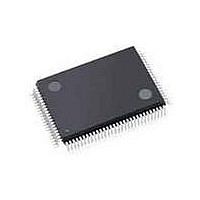C8051F040-TB Silicon Laboratories Inc, C8051F040-TB Datasheet - Page 204

C8051F040-TB
Manufacturer Part Number
C8051F040-TB
Description
BOARD PROTOTYPING W/C8051F040
Manufacturer
Silicon Laboratories Inc
Type
MCUr
Specifications of C8051F040-TB
Contents
Board
Processor To Be Evaluated
C8051F04x
Interface Type
USB
Lead Free Status / RoHS Status
Contains lead / RoHS non-compliant
For Use With/related Products
C8051F040
Lead Free Status / Rohs Status
Lead free / RoHS Compliant
- Current page: 204 of 328
- Download datasheet (3Mb)
C8051F040/1/2/3/4/5/6/7
The C8051F04x family of devices have a wide array of digital resources which are available through the
four lower I/O Ports: P0, P1, P2, and P3. Each of the pins on P0, P1, P2, and P3, can be defined as a Gen-
eral-Purpose I/O (GPIO) pin or can be controlled by a digital peripheral or function (like UART0 or /INT1 for
example), as shown in Figure 17.2. The system designer controls which digital functions are assigned
pins, limited only by the number of pins available. This resource assignment flexibility is achieved through
the use of a Priority Crossbar Decoder. The state of a Port I/O pin can always be read from its associated
Data register regardless of whether that pin has been assigned to a digital peripheral or behaves as GPIO.
The Port pins on Ports 1, 2, and 3 can be used as Analog Inputs to ADC2 (C8051F040/1/2/3 only), Analog
Voltage Comparators, and ADC0, respectively.
An External Memory Interface, which is active during the execution of an off-chip MOVX instruction, can be
active on either the lower Ports or the upper Ports. See
and On-Chip XRAM” on page 187
17.1. Ports 0 through 3 and the Priority Crossbar Decoder
The Priority Crossbar Decoder, or “Crossbar”, allocates and assigns Port pins on Port 0 through Port 3 to
the digital peripherals (UARTs, SMBus, PCA, Timers, etc.) on the device using a priority order. The Port
pins are allocated in order starting with P0.0 and continue through P3.7, if necessary. The digital peripher-
als are assigned Port pins in a priority order which is listed in Figure 17.3, with UART0 having the highest
priority and CNVSTR2 having the lowest priority.
204
Highest
Priority
Lowest
Priority
Latches
Port
/SYSCLK
CNVSTR0
CNVSTR2
T2, T2EX,
T3, T3EX,
T4,T4EX,
Comptr.
Outputs
UART0
UART1
SMBus
T0, T1,
/INT0,
/INT1
PCA
P0
P1
P2
P3
SPI
Figure 17.2. Port I/O Functional Block Diagram
(P0.0-P0.7)
(P1.0-P1.7)
(P2.0-P2.7)
(P3.0-P3.7)
8
8
8
8
2
4
2
2
6
2
8
for more information about the External Memory Interface.
XBR0, XBR1, XBR2,
P2MDIN, P3MDIN
XBR3 P1MDIN,
Crossbar
Decoder
To External
Registers
Priority
Rev. 1.5
Digital
Interface
Memory
(EMIF)
Section “16. External Data Memory Interface
8
8
8
8
P0MDOUT, P1MDOUT,
P2MDOUT, P3MDOUT
Comparators
Registers
ADC2
ADC0
Input
Input
Cells
Cells
Cells
Cells
To
To
To
P0
I/O
P1
I/O
P2
I/O
P3
I/O
External
Pins
P0.0
P0.7
P1.0
P1.7
P2.0
P2.7
P3.0
P3.7
Highest
Priority
Lowest
Priority
Related parts for C8051F040-TB
Image
Part Number
Description
Manufacturer
Datasheet
Request
R
Part Number:
Description:
SMD/C°/SINGLE-ENDED OUTPUT SILICON OSCILLATOR
Manufacturer:
Silicon Laboratories Inc
Part Number:
Description:
Manufacturer:
Silicon Laboratories Inc
Datasheet:
Part Number:
Description:
N/A N/A/SI4010 AES KEYFOB DEMO WITH LCD RX
Manufacturer:
Silicon Laboratories Inc
Datasheet:
Part Number:
Description:
N/A N/A/SI4010 SIMPLIFIED KEY FOB DEMO WITH LED RX
Manufacturer:
Silicon Laboratories Inc
Datasheet:
Part Number:
Description:
N/A/-40 TO 85 OC/EZLINK MODULE; F930/4432 HIGH BAND (REV E/B1)
Manufacturer:
Silicon Laboratories Inc
Part Number:
Description:
EZLink Module; F930/4432 Low Band (rev e/B1)
Manufacturer:
Silicon Laboratories Inc
Part Number:
Description:
I°/4460 10 DBM RADIO TEST CARD 434 MHZ
Manufacturer:
Silicon Laboratories Inc
Part Number:
Description:
I°/4461 14 DBM RADIO TEST CARD 868 MHZ
Manufacturer:
Silicon Laboratories Inc
Part Number:
Description:
I°/4463 20 DBM RFSWITCH RADIO TEST CARD 460 MHZ
Manufacturer:
Silicon Laboratories Inc
Part Number:
Description:
I°/4463 20 DBM RADIO TEST CARD 868 MHZ
Manufacturer:
Silicon Laboratories Inc
Part Number:
Description:
I°/4463 27 DBM RADIO TEST CARD 868 MHZ
Manufacturer:
Silicon Laboratories Inc
Part Number:
Description:
I°/4463 SKYWORKS 30 DBM RADIO TEST CARD 915 MHZ
Manufacturer:
Silicon Laboratories Inc
Part Number:
Description:
N/A N/A/-40 TO 85 OC/4463 RFMD 30 DBM RADIO TEST CARD 915 MHZ
Manufacturer:
Silicon Laboratories Inc
Part Number:
Description:
I°/4463 20 DBM RADIO TEST CARD 169 MHZ
Manufacturer:
Silicon Laboratories Inc










